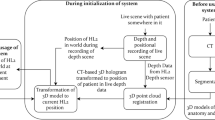Abstract
Purpose
We present a system which co-registers physical anatomy models with virtual three-dimensional (3D) representations. Interactions performed on the physical model by means of a 3D pointing device are directly reflected on its virtual counterpart. Complex anatomical information integrated into the virtual model thus becomes accessible through the physical interface in a simple and intuitive manner.
Methods
Using an optical tracking system, we implemented and tested a reference application that includes several tools for the exploration and quantification of anatomical models. We theoretically evaluated the accuracy of the landmark-based registration for different landmark configurations.
Results
Physicians and computer scientists found the system simple to learn and intuitive to use. By optimizing landmark configurations, the accuracy could be significantly increased, particularly for scenarios in which only selected regions required higher accuracy.
Conclusions
Physical anatomical models can benefit from the combination with a virtual counterpart in several ways. Applications include anatomical education and the study of patient-individual organ models. Optimizing the registration landmark configuration for specific applications can lower the accuracy requirements for the tracking system.
Similar content being viewed by others
References
McLachlan JC, Bligh J, Bradley P et al (2004) Teaching anatomy without cadavers. Med Educ 38(4): 418–424. doi:10.1046/j.1365-2923.2004.01795.x
Temkin B, Acosta E, Malvankar A et al (2006) An interactive three-dimensional virtual body structures system for anatomical training over the internet. Clin Anat 19(3): 267–274. doi:10.1002/ca.20230
Brenton H, Hernandeza J, Belloa F et al (2007) Using multimedia and Web3D to enhance anatomy teaching. Comput Educ 49(1): 32–53. doi:10.1016/j.compedu.2005.06.005
Kneebone R (2003) Simulation in surgical training: educational issues and practical implications. Med Educ 37(3): 267–277. doi:10.1046/j.1365-2923.2003.01440.x
Gallagher AG, Ritter EM, Champion H et al (2005) Virtual reality simulation for the operating room: proficiency-based training as a paradigm shift in surgical skills training. Ann Surg 241(2): 364–372. doi:10.1097/01.sla.0000151982.85062.80
Sørensen TS, Pedersen EM, Hansen OK et al (2003) Visualization of morphological details in congenitally malformed hearts: virtual three-dimensional reconstruction from magnetic resonance imaging. Cardiol Young 13(5): 451–460
Pommert A, Höhne K, Burmester E et al (2006) Computer-based anatomy: a prerequisite for computer-assisted radiology and surgery. Acad Radiol 13(1): 104–112. doi:10.1016/j.acra.2005.08.034
Greil GF, Wolf I, Kuettner A et al (2007) Stereolithographic reproduction of complex cardiac morphology based on high spatial resolution imaging. Clin Res Cardiol 96(3): 176–185. doi:10.1007/s00392-007-0482-3
Jacobs S, Grunert R, Mohr FW et al (2008) 3D-Imaging of cardiac structures using 3D heart models for planning in heart surgery: a preliminary study. Interact Cardiovasc Thorac Surg 7: 6–9. doi:10.1510/icvts.2007.156588
Ishii H (2008) Tangible bits: beyond pixels. In: TEI ’08 Proceedings of the 2nd international conference on tangible and embedded interaction, ACM, xv–xxv
Park H, Moon HC, Lee JY (2009) Tangible augmented prototyping of digital handheld products. Comput Ind 60(2): 114–125. doi:10.1016/j.compind.2008.09.001
Horn BKP (1987) Closed-form solution of absolute orientation using unit quaternions. JOSA 4: 629–642. doi:10.1364/JOSAA.4.000629
Maurer CR, Fitzpatrick JM, Wang M et al (1997) Registration of head volume images using implantable fiducial markers. IEEE Trans Med Imaging 16(4): 447–462. doi:10.1109/42.611354
Moghari MH, Ma B, Abolmaesumi P (2008) A theoretical comparison of different target registration error estimators. In: Proc MICCAI, pp 1032–1040
Wein W, Khamene A, Clevert DA et al (2007) Simulation and fully automatic multimodal registration of medical ultrasound. In: Proc MICCAI, pp 136–143
Navab N, Feuerstein M, Bichlmeier C (2007) Laparoscopic virtual mirror new interaction paradigm for monitor based augmented reality. In: Proc IEEE virtual reality, pp 43–50
Seitel M, Maier-Hein L, Rietdorf U (2009) Towards a mixed reality environment for preoperative planning of cardiac surgery. Stud Health Technol Inform 142: 307–309
West JB, Fitzpatrick JM, Toms SA et al (2001) Fiducial point placement and the accuracy of point-based, rigid body registration. Neurosurgery 48(4): 810–817. doi:10.1097/00006123-200104000-00023
Lepetit V, Fua P (2005) Monocular model-based 3D tracking of rigid objects: a survey. Comput Graph Vis 1(1): 1–89. doi:10.1561/0600000001
Author information
Authors and Affiliations
Corresponding author
Rights and permissions
About this article
Cite this article
Seitel, M., Maier-Hein, L., Seitel, A. et al. RepliExplore: coupling physical and virtual anatomy models. Int J CARS 4, 417–424 (2009). https://doi.org/10.1007/s11548-009-0363-5
Received:
Accepted:
Published:
Issue Date:
DOI: https://doi.org/10.1007/s11548-009-0363-5




